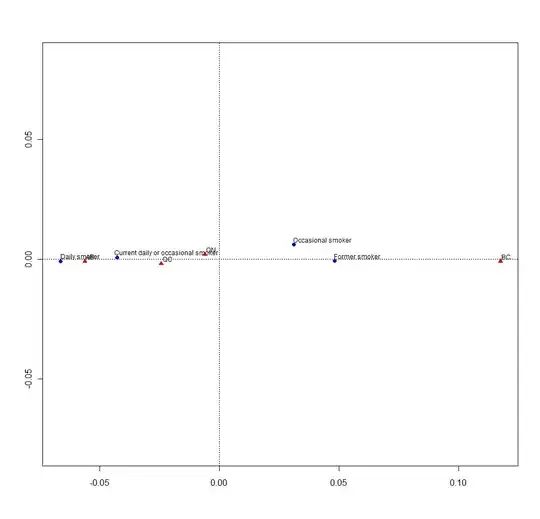I'd like to ensure that I understand the process correctly. This is a follow-up question to Interpreting 2D correspondence analysis plots
library(reshape)
library(ca)
df <- read.csv(file="http://www.bertelsen.ca/R/smokers.csv")
colnames(df)[7] <- "value" ## make reshape smart
df <- cast(df, SMOKER ~ GEO) ## reshape data
row.names(df) <- df$SMOKER ## rename rows
df <- df[2:ncol(df)] ## reset df
df <- df[-4,] ## Let's only look at people who have smoked
df <- df[c("AB","BC","ON","QC")] ## and only the biggest 4 provinces (KISS)
plot(ca(df))
summary(ca(df))
Output
Principal inertias (eigenvalues):
dim value % cum% scree plot
1 0.002523 99.9 99.9 *************************
2 3e-06000 0.1 100.0
3 00000000 0.0 100.0
-------- -----
Total: 0.002526 100.0
Rows:
name mass qlt inr k=1 cor ctr k=2 cor ctr
1 | Crrn | 265 1000 191 | -43 1000 191 | 1 0 43 |
2 | Dlys | 201 1000 351 | -66 1000 351 | -1 0 70 |
3 | Frmr | 470 1000 432 | 48 1000 432 | -1 0 98 |
4 | Occs | 65 1000 26 | 31 964 25 | 6 36 789 |
Columns:
name mass qlt inr k=1 cor ctr k=2 cor ctr
1 | AB | 116 1000 146 | -56 1000 146 | -1 0 34 |
2 | BC | 142 1000 775 | 118 1000 776 | -1 0 41 |
3 | ON | 434 1000 7 | -6 909 6 | 2 91 540 |
4 | QC | 308 1000 72 | -24 994 72 | -2 6 385 |
Looking at summary(ca(df)) I see that nearly 100% of the inertia is described by the row profile for both modalities (Type of smoker and Province, respectively).

What (I think) should be immediate takeaways are:
- You are more likely to be a daily smoker if you live in AB, QC, or ON
- You are more likely to be a former smoker if you live in BC
- You are least likely to be a daily smoker if you live in BC (this fits with Canadian wide understanding of BC's "active lifestyle" culture)
What could we say about occasional smokers? What would your analysis tell us through this correspondence plot and it's associated summary?
Data Source: Statistics Canada, Canadian Community Health Survey (CCHS 3.1), 2005. The CANSIM table 105-0427 was an update of CANSIM table 105-0227. More current data are in CANSIM tables 105-0501 and 105-0502.